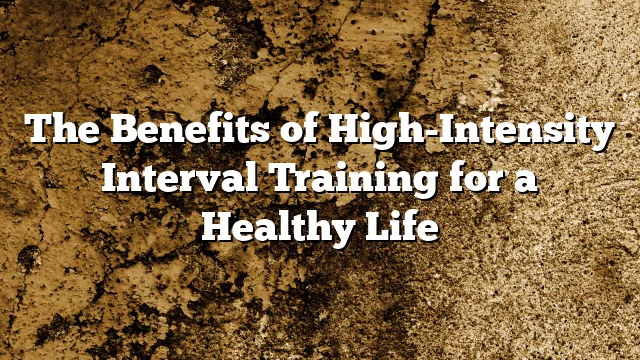
Fitness can improve health in many ways, yet many find it challenging to fit in the recommended 150 minutes of moderate physical activity each week.
High-intensity interval training (HIIT) is an efficient and effective form of fitness training that can help you meet your goals more quickly and easily. Here, we explore its many advantages as a part of fitness routines.
1. Improved Cardiovascular Health
The cardiovascular system is responsible for pumping blood throughout the body and is essential to good health.
One of the best ways to keep your heart healthy is with regular exercise – specifically interval training. Interval training involves short bursts of high-intensity physical activity followed by periods of rest or recovery and is an efficient means of improving both your health and fitness quickly.
Before beginning an exercise regimen, especially if you already suffer from medical conditions, it is always wise to seek clearance from your physician first. A recent study in Medicine and Science in Sports and Exercise discovered that high intensity interval training improved cardio fitness while raising total heart rate, peak heart rate and left ventricular function among overweight middle-aged men who exercised five times per week.
A high intensity interval training (HIIT) routine can range from simple jumping jacks to complex heart-pumping intervals. The most successful programs combine both strength training and endurance activities for an enjoyable workout experience; finding an instructor or group of friends to motivate you will be key in reaching this goal.
2. Decreased Risk of Type 2 Diabetes
Diabetes is a disease in which your blood sugar levels become too high, leading to damage in your blood vessels, heart, eyes and kidneys – and eventually your feet, arms and legs as well. Over time it may also impact nerves which connect the feet to arms to legs.
Lowering your risk of Type 2 diabetes can be done simply and quickly by adopting healthier lifestyle practices, including eating healthily, maintaining an ideal weight, engaging in regular physical exercise and not smoking.
Studies have demonstrated the importance of taking care to maintain normal blood pressure; those with normal blood pressure have a reduced risk of diabetes.
If your blood pressure is elevated, visit your physician to discuss ways of bringing it down. Your physician may suggest medications or lifestyle modifications as ways to bring down your numbers.
One way to decrease your risk of diabetes is by decreasing the amount of added sugars and refined carbohydrates in your diet, replacing them with fresh fruit, non-starchy vegetables and whole grains.
Beyond decreasing sugar intake, these foods may also help lower cholesterol and triglyceride levels to decrease the risk of heart attack, stroke and other cardiovascular problems.
Make sure that you consume an appropriate diet of fruits, vegetables, whole grains and lean proteins to achieve weight management and prevent the onset of diabetes. This will allow for healthier lifestyle choices while helping you remain within a healthy BMI range and avoid diabetes altogether.
Use high-intensity interval training (HIIT) as an effective way of exercising while reaping the rewards of living a healthy lifestyle. Consult with a health care professional about designing an HIT program tailored specifically to you and your schedule.
3. Decreased Risk of Heart Disease
One effective strategy for maintaining cardiovascular wellness is training your body to reach a high VO2 max or oxygen consumption per minute rate, one of the primary predictors of how effectively your heart pumps blood and how efficiently you perform other activities.
High-intensity interval training (HIIT), also known as circuit training or interval workouts, involves short bursts of intense physical activity interspersed with rest periods for improved cardiorespiratory fitness in both healthy and diseased populations. HIIT training can be done both with equipment or out on the road and has been shown to produce positive effects in cardiorespiratory fitness improvement.
Though HIIT may not be suitable for everyone, it is an effective and safe way to reach your fitness goals. Before embarking on any new workout plan or if you have any health concerns.
HIIT can dramatically enhance cardiovascular fitness. Studies have proven it significantly more effective at raising VO2 max and improving aerobic capacity than moderate-intensity continuous training (MCT).
Researchers attribute this effect to several factors, including better skeletal muscle conditioning, greater insulin sensitivity and an increase in metabolic rate. Most effective HIIT regimens consist of repeated bouts of short high-intensity intervals.
In order to optimize HIIT training, aim for three to five sessions every week and drink plenty of water – as proper hydration will maximize results from your efforts.
4. Decreased Risk of Stroke
HiIT (High-Intensity Interval Training) is an exercise technique which alternates short bursts of intense exercises with periods of rest, such as running, walking, cycling or swimming.
Researchers have recently discovered that women who participate in high intensity interval training (HIIT) programs may reduce their risk of stroke by 40%, by decreasing arterial hardening caused by age and leading to stroke in postmenopausal women.
Studies have also demonstrated the power of HIIT to help prevent heart disease, specifically coronary artery disease (CAD) and heart failure. This method works because HIIT increases oxygen consumption during exercise sessions – helping your body better utilise it while working out and ultimately improving heart health.
Martin Gibala, professor of exercise physiology at McMaster University in Hamilton, Ontario, Canada claims HIIT to be the ideal way to increase aerobic capacity and lower your chances of heart attack or stroke. For optimal health benefits and strength maintenance it must be practiced regularly over extended time periods.
Tamir suggests the fastest and simplest way to start using high intensity interval training is through an exercise program with short bursts of hard work followed by periods of rest – this should last anywhere between 1-3 minutes per interval and may be repeated several times throughout a workout session.
HIIT offers numerous health and wellbeing advantages, such as improved cardiovascular health, weight loss, muscle strength improvement and energy levels increase as well as overall mental wellbeing improvements. When considering starting HIIT exercises it is important to make sure it will be safe and comfortable for you – any concerns should be raised with your physician prior to commencing any routine HIIT session.
5. Decreased Risk of Obesity
Physical exercise is key to maintaining a healthy weight and improving health, yet many find it hard to fit regular workouts into their schedules. One solution may be high-intensity interval training (HIIT). HIIT involves short bursts of intense aerobic exercise followed by brief rest or low intensity activity that leads to increased fitness gains and weight loss without taking up much of one’s free time exercising.
HIIT has proven itself an effective strategy in combatting obesity, diabetes and cardiovascular conditions. Studies have demonstrated its ability to enhance body composition and cardiorespiratory fitness in overweight children in particular.
HIIT can also reduce the risk of obesity among adolescents. When compared with multi-treatment approaches, HIIT may prove more successful at decreasing cardiometabolic risk factors.
These benefits of HIIT may be attributable to its increased rate of fat oxidation. Furthermore, it’s more time-efficient than moderate-intensity continuous training (MICT), which may provide less rewarding experiences or lead to less weight loss.
For this reason, high intensity interval training (HIIT) is an invaluable addition to any fitness regime. It can be performed indoors or outdoors without needing special equipment.
If you have concerns about how HIIT could impact your health, consult with a physician prior to beginning. He or she can assist in choosing an effective type of HIIT exercise regimen suited for your fitness level and medical history.
Interval training entails strenuous, aerobic activities like running, swimming, biking or jogging that exert both your heart and lungs hard while recovering quickly afterwards. To start out slowly and gradually increase speed. You could also add different exercises like weightlifting to your workouts to keep it interesting!
